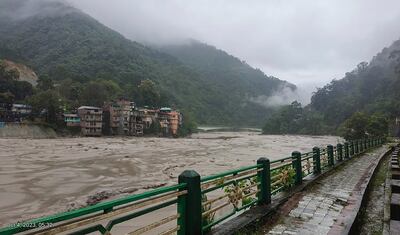At least 43 people, including 23 Indian army soldiers, were missing and at least five are dead after a powerful flash flood caused by intense rainfall tore through a valley in the mountainous north-eastern Sikkim state.
The Indian army said the flood occurred due to a sudden rise in the water level of Teesta river of up to six metres after a cloudburst hit South Lhonak Lake in north-western Sikkim.
A cloudburst is sudden and extremely heavy rain in a brief period, with the Indian Meteorological Department describing it as 100mm of rainfall within an hour.
The Indian army said some establishments along Lachen valley in the state’s Singtam area were affected.
“Release of water from the Chungthang dam led to a sudden increase in water level up to 15ft [4.5 metres] to 20ft [six metres] high downstream. This has led to army vehicles parked at Bardang near Singtam getting affected,” the Army's Eastern Command said.
It said some vehicles were reportedly submerged "under the slush" and search operations were under way.
The remote area lies close to India's border with Nepal, with Lhonak Lake at the base of a glacier in the snowy peaks that surround Kanchenjunga, the world's third-highest mountain.
The army said water released upstream from Chungthang dam meant the river was already more than 4.5 metres higher than usual.
The state government said five bodies had been recovered from Golitar and Singtam region.
“There are reports of loss of lives. Some people are still in their houses. Attempts are on to evacuate them,” said Tashi Chopel, a senior administrative official.

Several houses and other buildings were washed away and more than 3,000 people were evacuated and shifted to five relief camps.
National Disaster Relief Force said rescue and relief operations were continuing.
“We have three teams deployed and some teams are on standby,” said Bharat Bhusan Vaid, senior NRDF officer.
Prime Minister Narendra Modi “assured all possible support” to the state “in addressing the challenge”.
Flash floods are common during the monsoon season, which starts in June and normally begins to retreat towards the end of September. By October, the heaviest of the monsoon rains are usually over.
Climate change is increasing their frequency and severity, according to experts.
The incident has once again underscored a rise in cases of natural disasters due to climate change in the ecologically sensitive Himalayan region that stretches through a dozen states for up to 2,500 kilometres.
In the last week of August, a video showing eight concrete structures collapsing in the mountainous state of Himachal Pradesh went viral on social media in India.
There were no casualties but the incident shocked citizens as it came on the heels of a devastating season of widespread destruction and death caused by flash floods, landslides and cloudbursts that killed at least 400 people over two months.
Himachal Pradesh received 742mm of rainfall in the first 54 days of monsoon season, which reached the region in June, against the season's average of 730mm in four months until September, the national weather department said.

